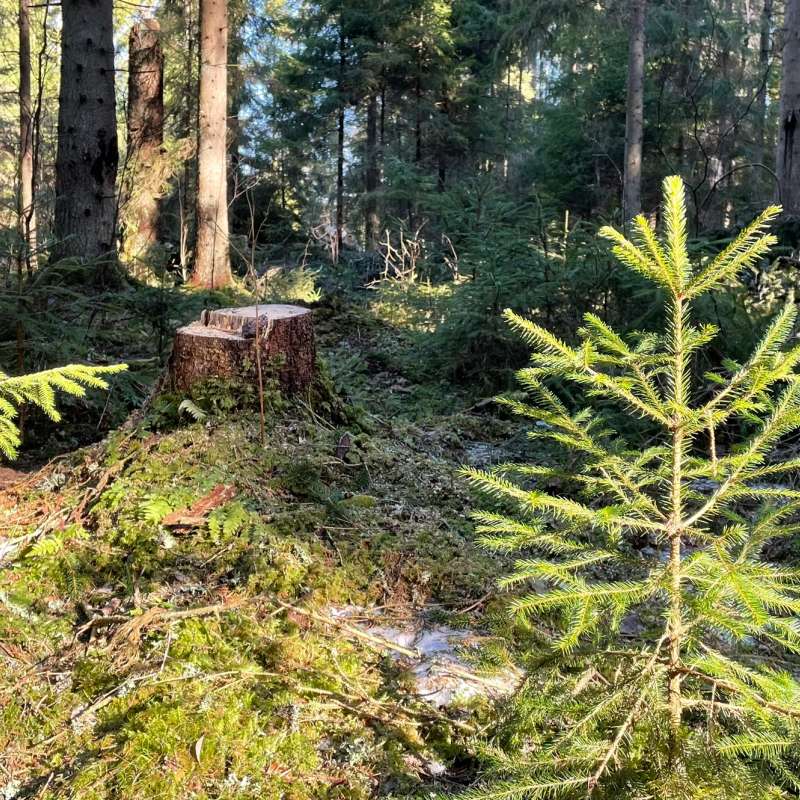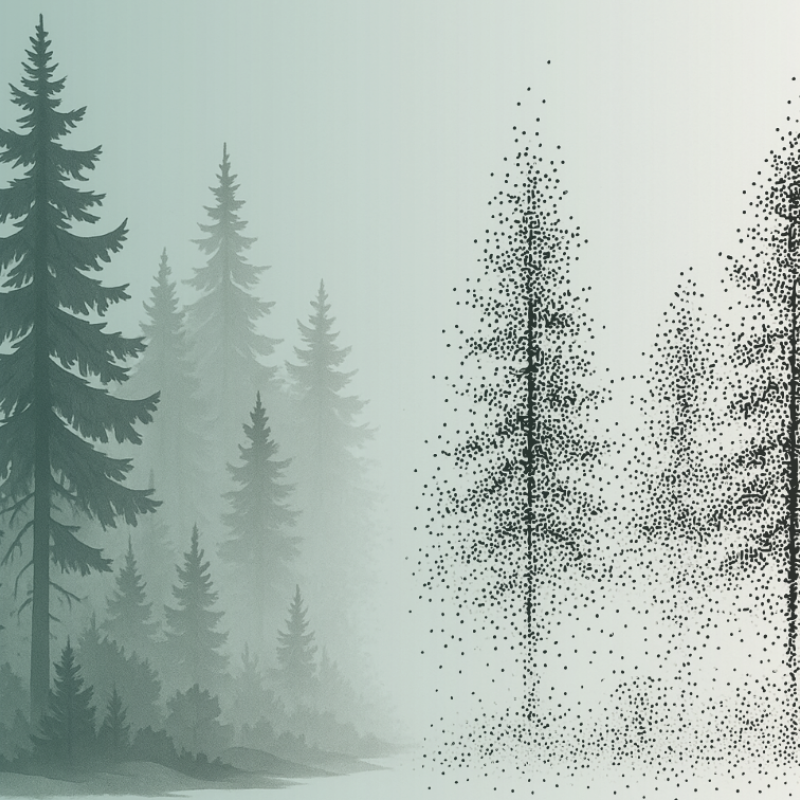Utdanning
-
Dr. forest. Georg-August-Universität Göttingen, Tyskland (2004)
-
M.Sc. Georg-August-Universität Göttingen, Tyskland (2002)
-
B.Sc. Georg-August-Universität Göttingen, Tyskland (2000)
Profesjonell erfaring
Før jeg begynte å jobbe ved NIBIO har jeg arbeidet mange år på forskjellige universiteter i Tyskland (Göttingen, Freiburg) og USA (Oregon State University, University of Maine System). I Tyskland har jeg forelest skogbehandling og -skjøtsel og i USA skogmåling og -taksering. Jeg er interessert i alternativ skogbehandling, som for eksempel blandingsskog, løvtreskog og selektive hogstformer. Jeg har erfaring med modelleringen av enkelttrevekst og skogproduksjon. Sammen med mine kolleger er jeg ansvarlig for NIBIOs langsiktige feltforsøk i skog.
Utvalgte publikasjoner
Modrow T, Pyttel P, Kuehne C, Kohnle U, Bauhus J. 2025. Variation in understorey radiation in different types of partial regeneration harvests in mature sessile oak (Quercus petraea [Mattuschka] Liebl.) forests. For Ecol Manage 594: 122935.
Kuehne C, Maleki K, Merlin M, Granhus A. 2025. Interactive effects of species composition, site quality and drought on growth dynamics of Norway spruce and Scots pine stands in Norway. For Ecol Manage 590: 122804.
Modrow T, Ziegler K, Pyttel P, Kuehne C, Kohnle U, Bauhus J. 2025. The role of photosynthesis and light conditions for competition dynamics among Quercus petraea, Fagus sylvatica, Carpinus betulus, and Rubus subg. Rubus in the regeneration phase. For Ecol Manage 594: 122756.
Kuehne C, Granhus A, Holt Hanssen K. 2025. Analyzing growth characteristics and diameter distributions of young Norway spruce plantations in Norway. New For 56: 32.
Kuehne C, Granhus A, Astrup R. 2025. Assessing the profitability of thinning Norway’s spruce and pine forests: an analysis accounting for machine trail effects. Scand J For Res 40(1): 41–51.
Kuehne C, Zimmer K, Smith A. 2024. The relationship between branch scar attributes and knot features in birch (Betula pendula and B. pubescens). Wood Sci Technol 58(3): 907–921.
Kuehne C, Weiskittel AR, Kershaw Jr. JA. 2022. Development and evaluation of refined annualized individual tree diameter and height increment equations for the Acadian Variant of the Forest Vegetation Simulator: Implication for forest carbon estimates. Math Comput For Nat-Res Sci 14(2): 9-31.
Kuehne C, Weiskittel AR, Granhus A. 2022. Examining approaches for modeling individual tree growth response to thinning in Norway spruce. For Ecosyst 9: 100060.
Maleki K, Rasmus A, Kuehne C, McLean JP, Antón-Fernández C. 2022. Stand-level growth models for long-term projections of the main species groups in Norway. Scan J For Res 37(2): 130-143.
Kuehne C, McLean P, Maleki K, Antón-Fernández C, Rasmus A. 2022. A stand-level growth and yield model for thinned and unthinned even-aged Scots pine forests in Norway. Silva Fenn 56(1): 1062.
Annighöfer P, Mund M, Seidel D, Ammer C, Ameztegui A, Balandier P, Bebre I, Coll L, Collet C, Hamm T, Huth F, Schneider H, Kuehne C, Löf M, Petritan A, Petritan C, Schall P, Bauhus J. 2022. Examination of aboveground attributes to predict belowground biomass of young trees. For Ecol Manage 505: 119942.
Nosko P, Moreau K, Kuehne C, Major KC, Bauhus J. 2022. Does a shift in shade tolerance as suggested by seedling morphology explain differences in regeneration success of northern red oak in native and introduced ranges? J For Res 33(3): 949-962.
Kern CC, Kenefic LS, Kuehne C, Weiskittel AR, Kaschmitter SJ, D’Amato AW, Dey DC, Kabrick JM, Palik BJ, Schuler TM. 2021. Relative influence of stand and site factors on aboveground live-tree carbon sequestration and mortality in managed and unmanaged forests. For Ecol Manage 492: 119266.
Mäkinen H, Henttonen HM, Kohnle U, Kuehne C, Nöjd P, Yue C, Klädtke J, Siipilehto J. 2021. Site carrying capacity of Norway spruce and Scots pine stands has increased in Germany and northern Europe. For Ecol Manage 492: 119214.
Kohler M, Pyttel P, Kuehne C, Modrow T, Bauhus J. 2020. On the knowns and unknowns of natural regeneration of silviculturally managed sessile oak (Quercus petraea (Matt.) Liebl.) forests – a literature review. Ann For Sci 77: 101.
Kuehne C, Pyttel P, Modrow T, Kohnle U, Bauhus J. 2020. Seedling development and regeneration success after ten years following group selection harvesting in a sessile oak (Quercus petraea (Matt.) Liebl.) stand. Ann For Sci 77: 71.
Modrow T, Kuehne C, Saha S, Bauhus J, Pyttel PL. 2020. Photosynthetic performance, height growth, and dominance of naturally regenerated sessile oak (Quercus petraea [Mattuschka] Liebl.) seedlings in small-scale canopy openings of varying sizes. Eur J For Res 139: 41–52.
Kuehne C, Russell MB, Weiskittel AR, Kershaw Jr. JA. 2020. Comparing strategies for representing individual-tree secondary growth in mixed-species stands in the Acadian Forest region. For Ecol Manage 459: 117823.
Weiskittel AR, Kuehne C. 2019. Evaluating and modeling variation in site-level maximum carrying capacity of mixed-species forest stands in the Acadian Region of northeastern North America. For Chron 95(03): 171-182.
Kuehne C, Weiskittel AR, Legaard KR, Simons-Legaard EM. 2019. Development and comparison of various stand- and tree-level modeling approaches to predict harvest occurrence and intensity across the mixed forests in Maine, northeastern US. Scan J For Res 34(8): 739-750.
Puhlick JJ, Kuehne C, Kenefic LS. 2019. Crop tree growth response and quality after silvicultural rehabilitation of cutover stands. Can J For Res 49(6): 670-679.
Kuehne C, Weiskittel AR, Waskiewicz J. 2019. Comparing performance of contrasting distance-independent and distance-dependent competition metrics in predicting individual tree diameter increment and survival within structurally-heterogeneous, mixed-species forests of Northeastern United States. For Ecol Manage 433: 205–216.
Kuehne C, Puhlick J, Weiskittel A, Cutko A, Cameron D, Sferra N, Schlawin J. 2018. Metrics for comparing stand structure and dynamics between Ecological Reserves and managed forest of Maine, USA. Ecology 99: 2876.
Kuehne C, Weiskittel AR, Pommerening A, Wagner RG. 2018. Evaluation of 10-year temporal and spatial variability in structure and growth across contrasting commercial thinning treatments in spruce-fir forests of northern Maine, USA. Ann For Sci 75: 20.
Bose AK, Weiskittel AR, Kuehne C, Wagner RG, Turnblom E, Burkhart HE. 2018. Tree-level growth and survival following commercial thinning of four major softwood species in North America. For Ecol Manage 427: 355-364.
Bose AK Weiskittel AR, Kuehne C, Wagner RG, Turnblom E, Burkhart HE. 2018. Does commercial thinning improve stand-level growth of the three most commercially important softwood forest types of North America? For Ecol Manage 409: 683-693.
Drössler L, Fahlvik N, Wysocka NK, Hjelm K, Kuehne C. 2017. Natural regeneration in a multi-layered Pinus sylvestris-Picea abies forest after target diameter harvest and soil scarification. Forests 8: 35.
Saha S, Kuehne C, Bauhus J. 2017. Lessons learned from oak cluster planting trials in central Europe. Can J For Res 47: 139-148.
Bose A, Weiskittel AR, Wagner RG, Kuehne C. 2016. Assessing the factors influencing natural regeneration patterns in the diverse, multi-cohort, and managed forests of Maine, USA. J Veg Sci 27: 1040-1050.
Weiskittel A, Kuehne C, McTague JP, Oppenheimer M. 2016. Development and evaluation of an individual tree growth and yield model for the mixed species forest of the Adirondacks Region of New York, USA. For Ecosyst 3: 26.
Kuehne C, Weiskittel AR, Wagner RG, Roth BE. 2016. Development and evaluation of individual tree- and stand-level approaches for predicting spruce-fir response to commercial thinning in Maine, USA. For Ecol Manage 376: 84-95.
Annighöfer P, Ameztegui A, Ammer C, Balandier P, Bartsch N, Bolte A, Coll L, Collet C, Ewald J, Frischbier N, Gebereyesus T, Haase J, Hamm T, Hirschfelder B, Huth F, Kändler G, Kahl A, Kawaletz H, Kuehne C, Lacointe A, Lin N, Löf M, Malagoli P, Marquier A, Müller S., Promberger S, Provendier D, Röhle H, Sathornkich J, Schall P, Scherer-Lorenzen M, Schröder J, Seele C, Weidig J, Wirth C, Wolf H, Wollmerstädt J, Mund M. 2016. Species-specific and generic biomass equations for seedlings and saplings of European tree species. Eur J For Res 135: 313-329.
Kuehne C, Karrie C, Forrester DI, Kohnle U, Bauhus J. 2015. Root system development in naturally regenerated Douglas-fir saplings as influenced by canopy closure and crowding. J For Sci 61: 406-415.
Kuehne C, Weiskittel AR, Fraver S, Puettman KJ. 2015. Effects of thinning induced changes in structural heterogeneity on growth, ingrowth, and mortality in secondary coastal Douglas-fir forests. Can J For Res 45: 1448-1461.
Kühne C, Jacob A, Gräf M. 2014. The practice of establishing and tending oak (Qercus petraea [Matt.] Liebl., Q. robur L.) stands – An interview-based study in the eastern Upper Rhine Plain, Germany. Forstarchiv 85: 179-187. In German
Saha S, Kuehne C, Bauhus J. 2014. Intra- and interspecific competition differently influence growth and stem quality of young oaks (Quercus robur L. and Q. petraea (Mattuschka) Liebl.). Ann For Sci 71: 381-393
Kuehne C, Nosko P, Horwath T, Bauhus J. 2014. A comparative study of physiological and morphological seedling traits associated with shade tolerance in introduced red oak (Quercus rubra L.) and native hardwood tree species in southwestern Germany. Tree Physiol 34: 184-193
Saha S, Kuehne C, Bauhus J. 2013. Tree species richness and stand productivity in low-density cluster plantings with oaks (Quercus robur and Q. petraea). Forests 4: 650-655
Kuehne C, Kublin E, Pyttel P, Bauhus J. 2013. Growth and form of Quercus robur and Fraxinus excelsior respond distinctly different to initial growing space: results from 24-year-old Nelder experiments. J For Res 24: 1-14
Major KC, Nosko P, Kuehne C, Campbell D, Bauhus J. 2013. Regeneration dynamics of non-native northern red oak (Quercus rubra L.) populations as influenced by environmental factors: a case study in managed hardwood forests of south-western Germany. For Ecol Manage 291: 144-153
Bauhus J, Puettmann KJ, Kühne C. 2013. Is close-to-nature forest management in Europe compatible with managing forests as complex ecosystems? In Messier C., Puettmann K., and Coates K.D. (eds.) Managing forests as complex adaptive systems. Building resilience to the challenge of global change. Routledge Abingdon, pp. 187-213
Briggs N, Kuehne C, Kohnle U, Bauhus J. 2012. Root system response of naturally regenerated Douglas-fir (Pseudotsuga menziesii) after complete overstory removal. Can J For Res 42: 1858-1864
Saha S, Kuehne C, Kohnle U, Brang P, Ehring A, Geisel J, Leder B, Muth M, Petersen R, Peter J, Ruhm W, Bauhus J. 2012. Growth and quality of young oaks (Quercus robur and Q. petraea) grown in cluster plantings in Central Europe: a weighted meta-analysis. For Ecol Manage 283: 106-118
Kühne C, Bauhus J, Hörnig T, Oh S. 2011. Effects of canopy closure, crowding and plant size on root system development in Douglas-fir saplings. Forstarchiv 82: 184-194. In German
Kuehne C, Donath C, Müller-Using SI, Bartsch N. 2008. Nutrient fluxes via leaching from coarse woody debris in a Fagus sylvatica forest in the Solling Mts., Germany. Can J For Res 38: 2405-2413
Kuehne C, Puettmann KJ. 2008. Natural regeneration in thinned Douglas-fir stands in western Oregon. J Sust For 27: 246-274
Kühne C, Bartsch N. 2007. Germination of acorns and development of oak seedlings (Quercus robur L.) following flooding. J For Sci 53: 391-399
Kühne C, Puettmann KJ. 2006. Large scale management experiments – new approaches to silvicultural research. Forstarchiv 77: 102-109. In German
Kühne C, Bartsch N, Röhrig E. 2005. Silvicultural management of floodplain forests of the Upper Rhine Valley in special consideration of Quercus robur L. Schriften aus der Forstlichen Fakultät der Universität Göttingen und der Niedersächsichen Forstlichen Versuchsanstalt 140. J.D. Sauerländer’s Verlag Frankfurt am Main. 139 p. In German
Kühne C, Bartsch N. 2005. Fructification and seedling development of pedunculate oak (Quercus robur) in floodplain forests of the Upper Rhine Valley. Forstarchiv 76: 16-23. In German
Kühne C, Bartsch N. 2004. On the natural regeneration of mixed stands of European beech (Fagus sylvatica) and Norway spruce (Picea abies) in the Solling Mts., Germany. Forst u. Holz 58: 3-7. In German



